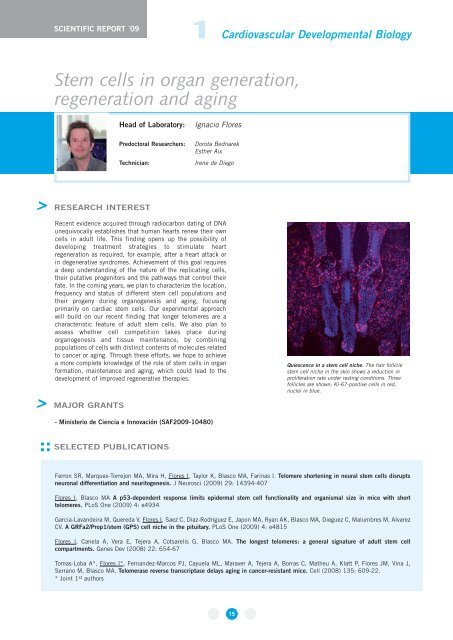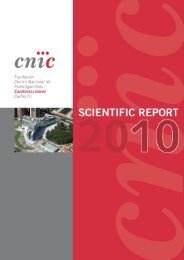Appendix - CNIC
Appendix - CNIC
Appendix - CNIC
Create successful ePaper yourself
Turn your PDF publications into a flip-book with our unique Google optimized e-Paper software.
SCIENTIFIC REPORT ´09<br />
> RESEARCH INTEREST<br />
Recent evidence acquired through radiocarbon dating of DNA<br />
unequivocally establishes that human hearts renew their own<br />
cells in adult life. This finding opens up the possibility of<br />
developing treatment strategies to stimulate heart<br />
regeneration as required, for example, after a heart attack or<br />
in degenerative syndromes. Achievement of this goal requires<br />
a deep understanding of the nature of the replicating cells,<br />
their putative progenitors and the pathways that control their<br />
fate. In the coming years, we plan to characterize the location,<br />
frequency and status of different stem cell populations and<br />
their progeny during organogenesis and aging, focusing<br />
primarily on cardiac stem cells. Our experimental approach<br />
will build on our recent finding that longer telomeres are a<br />
characteristic feature of adult stem cells. We also plan to<br />
assess whether cell competition takes place during<br />
organogenesis and tissue maintenance, by combining<br />
populations of cells with distinct contents of molecules related<br />
to cancer or aging. Through these efforts, we hope to achieve<br />
a more complete knowledge of the role of stem cells in organ<br />
formation, maintenance and aging, which could lead to the<br />
development of improved regenerative therapies.<br />
1 Cardiovascular Developmental Biology<br />
Stem cells in organ generation,<br />
regeneration and aging<br />
> MAJOR GRANTS<br />
Head of Laboratory: Ignacio Flores<br />
Predoctoral Researchers: Dorota Bednarek<br />
Esther Aix<br />
Technician: Irene de Diego<br />
- Ministerio de Ciencia e Innovación (SAF2009-10480)<br />
SELECTED PUBLICATIONS<br />
15<br />
Quiescence in a stem cell niche. The hair follicle<br />
stem cell niche in the skin shows a reduction in<br />
proliferation rate under resting conditions. Three<br />
follicles are shown: Ki-67-positive cells in red,<br />
nuclei in blue.<br />
Ferron SR, Marques-Torrejon MA, Mira H, Flores I, Taylor K, Blasco MA, Farinas I. Telomere shortening in neural stem cells disrupts<br />
neuronal differentiation and neuritogenesis. J Neurosci (2009) 29: 14394-407<br />
Flores I, Blasco MA A p53-dependent response limits epidermal stem cell functionality and organismal size in mice with short<br />
telomeres. PLoS One (2009) 4: e4934<br />
Garcia-Lavandeira M, Quereda V, Flores I, Saez C, Diaz-Rodriguez E, Japon MA, Ryan AK, Blasco MA, Dieguez C, Malumbres M, Alvarez<br />
CV. A GRFa2/Prop1/stem (GPS) cell niche in the pituitary. PLoS One (2009) 4: e4815<br />
Flores I, Canela A, Vera E, Tejera A, Cotsarelis G, Blasco MA. The longest telomeres: a general signature of adult stem cell<br />
compartments. Genes Dev (2008) 22: 654-67<br />
Tomas-Loba A*, Flores I*, Fernandez-Marcos PJ, Cayuela ML, Maraver A, Tejera A, Borras C, Matheu A, Klatt P, Flores JM, Vina J,<br />
Serrano M, Blasco MA. Telomerase reverse transcriptase delays aging in cancer-resistant mice. Cell (2008) 135: 609-22.<br />
* Joint 1 st authors



